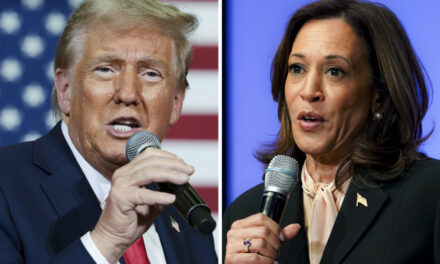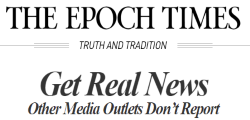We support our Publishers and Content Creators. You can view this story on their website by CLICKING HERE.
BETHLEHEM, Pa.—With its 19 electoral votes dwarfing any other swing state, Pennsylvania is perhaps the most critical battleground in the fight for the Electoral College. Whoever wins the Keystone State this year appears likely to become the next president.
It’s part of the “blue wall”—which also includes Michigan and Wisconsin—that has voted for a Democratic candidate in every presidential election for 20 years before candidate Donald Trump snatched them in 2016. Trump lost all three to candidate Joe Biden four years later.
Pennsylvania’s industries, its population demographics, and its regional geography all make the state critical to win in the presidential election, political experts told The Epoch Times.
“It looks like Pennsylvania is a very close race in which both candidates are, for good reason, campaigning hard,” Robert Shapiro, a political science professor from Columbia University, told The Epoch Times.
“The Democrats may have an edge in the ‘ground game,’ and [Governor] Josh Shapiro campaigning is a plus, but the state has had an increasing number of registered Republican voters.”
Both campaigns have blitzed through the state in the past two months, holding countless rallies in cities from east to west.
“Just look at how many times that both candidates have been, and how many more times they will continue to visit Pennsylvania before the election,” J. Edwin Benton, a political science professor at the University of South Florida, told The Epoch Times. “This could be like a revolving door.”
(Left) A campaign billboard of Democratic presidential nominee Vice President Kamala Harris is displayed in Allentown, Pa., on Nov. 2, 2024. (Right) An electronic billboard shows an “Americans for Trump” advertisement in Easton, Pa., on Nov. 1, 2024. Michael M. Santiago/Getty Images, Samuel Corum/AFP via Getty Images
State Demographics
“Pennsylvania’s demographics, in some key ways, look a lot like those of the country as a whole,” Daniel Hopkins, a political science professor at the University of Pennsylvania, told The Epoch Times.
That includes black residents, who account for 14.9 percent of the country’s population and 12.7 percent of Pennsylvania’s population in 2021. The state lacks the same number of Evangelical Protestant voters as some southern states.
By 2023, the state was 80.6 percent white, 12.3 percent black, 8.9 percent Hispanic or Latino, and 4.3 percent Asian, Native Hawaiian, or other Pacific Islander, according to U.S. Census estimates.
Industry’s Impacts on State Politics
Pennsylvania—a powerhouse for industry—has a history of agriculture, textiles, coal and iron ore mining, and steel and rail production. This focus on industrialization impacted the state’s political makeup.
Before the 1930s and ‘40s, Pennsylvania was a Republican stronghold, Richardson Dilworth, a political science professor at Drexel University in Philadelphia, told The Epoch Times.
“Pennsylvania was a real sort of stalwart in terms of [the] Republican machine, and that had a lot to do with the consolidated industries” of coal, steel, and railroads, Dilworth said.
After World War II, the commonwealth’s working-class residents became increasingly unionized, yielding a “strong voting block of Democrats,” he added.
Pennsylvania’s political diversity made it competitive during presidential elections, swinging to either party until 1992.
“We do have many communities that are very dependent on industry, on manufacturing, on energy production, as those voters have to look … more Republican, less Democratic,” Hopkins said.
Pennsylvania, the birthplace of commercial oil production in 1859, is still a massive producer to this day. Energy output expanded to natural gas in 1906 and fracking in 2004, making the state second only to Texas in fuel exports.
A “double-digit percentage of the workforce in Pennsylvania in some way, shape, or form, works in the energy industry,” Matthew Pitzarella, director of the Energy, Environment & Natural Resources Institution at Buchanan Ingersoll & Rooney PC law firm, told The Epoch Times.
The oil and gas industry signs leases with landowners to drill, and some earn millions of dollars a year.
“Fracking is huge,” Holly Thomas, a resident of Williamsport, Pennsylvania, told The Epoch Times. “That’s a lot of people’s livelihoods, jobs.”
Thomas said she is voting for Trump in part because of his energy agenda.
Members of “Steelworkers for Trump” gift Republican presidential candidate former President Donald Trump a hard hat during a campaign rally at Arnold Palmer Regional Airport in Latrobe, Pa., on Oct. 19, 2024. Jim Watson/AFP via Getty Images
“We’re an industrial state,” Jim Lee, president and CEO of Susquehanna Polling, Lee told The Epoch Times. “We have a big chunk of these white, non-college educated, working-class voters, and Trump’s winning them … which I think shows he does have strength in Pennsylvania.”
While Vice President Kamala Harris has not focused on energy during campaign stops in the Keystone State, Trump’s running mate, Sen. JD Vance (R-Ohio), touted the state’s energy reserves during a rally in New Kensington, Pennsylvania, on Aug. 15.
“We got plenty of [oil and gas] in western Pennsylvania. Let’s allow these guys to get it out of the ground,” Vance said.
Geographical Diversity
Pennsylvania is also geographically unique.
Norah Hooper, a retiree and Harris supporter, recently moved to eastern Pennsylvania and told The Epoch Times that she is amazed by the state’s outdoors and wonderful hiking opportunities.
“A real key to understanding [Pennsylvania’s] political significance is that, first of all, it’s big, so obviously, most of the state is relatively underpopulated,” Dilworth said. The state stretches from the East Coast to the Midwest.
“It’s got this varied sort of political geography, and it captured a sort of swath of political diversity that a lot of other states don’t capture. So that gives it a sort of mixed political character,” he said.
That diversity includes a large rural and urban population, Hopkins said.
Dilworth said the long term effects of the North American Free Trade Agreement (NAFTA) changed everything, which he called a “slow burn realignment,” moving many of those communities to the right.
“That trade liberalization really hurts, especially the sort of heavier manufacturing part of the state,” he added.
The trade agreement gutted unionization, eroding large portions of the Democratic Party’s coalition, Dilworth said.
In 2000, Mercer, Lawrence, Beaver, Washington, Green, Fayette, and Cambria counties all voted for the Democratic ticket by margins ranging from 1 to 16 percent. Those same counties backed Trump by between 17 and 43 percent in 2016 and 2020.
However, those same counties, minus Washington, lost population between 2010 and 2020, by as much as 7 percent. Compared to Allegheny, Bucks, Chester, and Montgomery counties—all Biden bulwarks in 2020—the “strongest Republican parts of the state are losing population faster,” Dilworth said.
That blunts some of the GOP’s increasing gains on Democratic voter registration in Pennsylvania over the past few elections. Democrats had a 1.2 million-person voter registration advantage over Republicans in 2008. As of September, that advantage had been shaved down to slightly more than 300,000.
Democratic presidential candidate Vice President Kamala Harris speaks during a campaign rally in Philadelphia on Oct. 27, 2024. Saul Loeb/AFP via Getty Images
“I wouldn’t say that Trump winning in 2016 in Pennsylvania and Biden winning in 2020 is particularly indicative of much in terms of whether or not the state is Republican or Democrat,” Dilworth said. “It’s a reflection of the current political status of the state, which is highly mixed.”
There’s also no guarantee that a registered voter will necessarily support their party’s ticket, either.
“There are a fair number of people who registered as Democrats 20 years ago and had no reason to update their party registration, but have long since stopped voting like Democrats,” Hopkins said.
Some, including John Knob from Erie, who is a retired union member that worked for General Electric, have not always supported Democrats in state and national elections, including for candidate Richard Nixon in 1968.
“A lot of times I’ll vote a mixed ticket, just because I try to vote for who I believe is going to do the better job, not necessarily down party lines,” Knob, who is supporting Harris this year, told The Epoch Times.
Pennsylvanians interested in voting early had until 5 p.m. on Oct. 29 to request a mail-in ballot, and can return those ballots to a drop-off location or to their County Board of Elections by 8 p.m. on Election Day. Those with disabilities or other emergencies may still be able to request a mail ballot after the deadline.
Key Issues Drive Turnout
Both campaigns are working to drive turnout in the Keystone State this year. Trump has turned to SpaceX and Tesla CEO Elon Musk’s America PAC, which is pouring millions into Pennsylvania to mobilize voters statewide, and Harris has a massive ground operation in the state that is knocking on doors and handing out campaign literature to local residents.
Despite Republican gains in voter registration, there’s a major factor that Dilworth says could be a problem for Trump: the 2022 Supreme Court Dobbs decision that overturned Roe v. Wade. Trump has repeatedly taken credit for appointing the Supreme Court justices who joined in the majority in the 6–3 decision.
“The Dobbs decision is a critical realigning point between the Republicans and Democrats. This is going to exacerbate the existing gender divide since the Clinton administration, and that could work far more to the advantage of Democrats,” Dilworth said.
Democrats are hoping a mix of frustration over the loss of federal abortion rights and general enthusiasm for their ticket will push Harris over the finish line nationwide.
Allegheny County Public Works employees guide voters to the county ballot return outside the Allegheny County Office Building in Pittsburgh on Oct. 29, 2024. Jeff Swensen/Getty Images
Abortion, however, is not the only issue on voters’ minds.
“One of the biggest issues in Erie right now is definitely the cost of living,” Heath Ulmer, an 11th-grade English teacher and Harris supporter from Erie, told The Epoch Times.
Even with cooling inflation and other economic improvements, the financial woes of the last three and a half years are largely baked into the country’s economy now, Benton said.
“Prices will go up, but they’ll never roll back. So we’re stuck with that,” Benton said. “Maybe inflation slowed down, but I’m stuck with those price increases for the rest of my life.”
Even with the pains many are experiencing from the economy, Benton said that some of the people who supported Trump in 2016 and 2020 may not see the man as the same candidate today, whether it’s his rhetoric or his criminal allegations. He thinks that could be a reason why Trump has returned to some of the same messaging he used eight years ago when he prevailed in Pennsylvania.
Electoral College Supremacy
“If Trump holds on to North Carolina and recaptures Georgia, Pennsylvania would give him enough electoral votes to win the election,” Robert Shapiro said, noting that Pennsylvania reigns supreme with its 19 electoral votes.
“In contrast, Harris could lose Arizona, Nevada, Georgia, and North Carolina and win the electoral vote if she wins all of Michigan, Wisconsin, and Pennsylvania—so losing Pennsylvania would be decisive in a loss,” he said.
Turnout is a factor as well, with both campaigns vying for a surge in their key areas—urban and suburban pockets for Harris, and rural and industrial communities for Trump
“Trump needs high turnout now,” Lee said. “Now, having said that, high turnout still, to some extent, benefits Harris because it means turnout was up on college campuses. And she’s winning those voters in our nationwide poll … by a 61 to 33 margin.”
The race will likely come down to whichever voting blocs the two campaigns can energize the most.
“If on election night you hear that there’s high turnout, and in particular, if there’s high turnout outside of the cities that are Kamala Harris’s base, then you should expect that that’s good news for Trump,” Hopkins said.
Arjun Singh contributed to this report.

 Conservative
Conservative  Search
Search Trending
Trending Current News
Current News 







